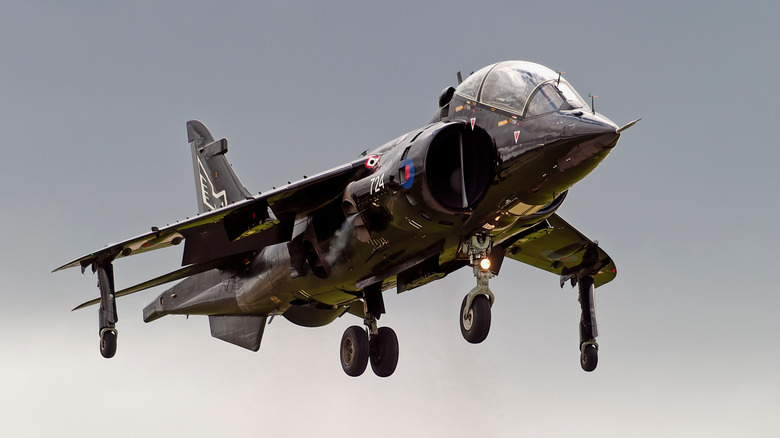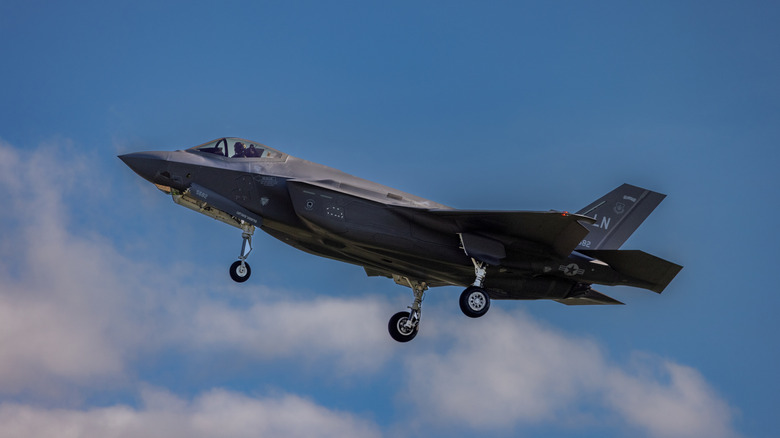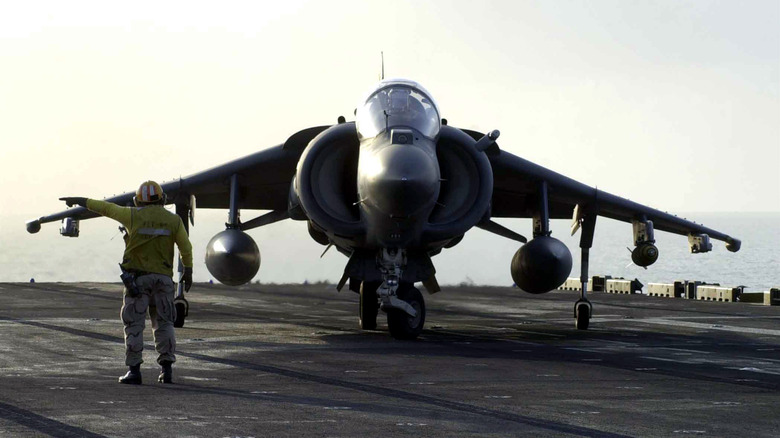Can Fighter Jets Hover In Place? Here's What You Need To Know
Fighter jets are some of the world's most advanced military tools. With their blinding speed, impressive maneuverability, and cutting-edge technology, there is no shortage of reasons why these aircraft are iconic. Although aerial warfare has existed for over a century, it wasn't until 1942 that the first fighter jet, the Messerschmitt Me 26, took to the skies in test flights. This aircraft was revolutionary in many ways. Capable of reaching speeds of 559 mph, it was also armed with four 30-millimeter Mk108 cannons, making it a formidable presence in the skies. However, its dominance would be short-lived, and by the end of World War II, many would view the Me 26 as a failure, particularly in the context of the theater of war in which it operated. Nevertheless, its introduction showcased the potential of equipping military aircraft with jet technology.
By the time the U.S. deployed its Air Force against the North Vietnamese, several of its fighter aircraft, like the F-4 Phantom II, were already jet-powered. As the years have gone by, more technology has emerged, enhancing what already existed while introducing more advanced systems to expand the capabilities of fighters. Among the most discussed features is hovering, which only a few of these aircraft can achieve. These include the F-35 Lightning II, known as the most advanced fighter jet to date, and the jets in the Harrier family, such as the McDonnell Douglas AV-8B Harrier II. But how exactly do these jets hover, and why is this technology so limited?
How the F-35 Lightning II is able to hover
Achieving hovering capabilities for these jets involves complex processes, which can be summarized as a combination of thrust vectoring and a vertical lift system. For the F-35, Rolls-Royce's LiftSystem merges fan system technology with digital control, allowing the F-35 to not only perform powerful short take-off and vertical landing (STOVL) maneuvers but also to hover when necessary. Conversely, Harrier jets direct their four swiveling nozzles downward, directing thrust to achieve vertical lift and hover when required. However, a lot goes into both of these systems in order to achieve hovering. Let's start with the F-35.
The F-35 is one of the most discussed fighter jets of the 21st century, with a total of 19 countries joining efforts to support its development. The first F-35 took its inaugural flight in 2006. By that time, several systems from renowned American companies such as General Electric, Northrop Grumman, and Pratt & Whitney were already established, along with significant contributions from British manufacturers, particularly Rolls-Royce, which equipped the F-35 with the LiftSystem. This system features a 50-inch two-stage counter-rotating Lyftfan capable of generating 20,000 pounds of downward thrust, roll posts that each direct 1,950 pounds of thrust from the main engine, and the 3-Bearing Swivel Module (3BSM), a swiveling jet pipe capable of delivering up to 18,000 pounds of thrust.
The Lyftfan, situated behind the cockpit, receives 29,000 shaft horsepower from the F-35's main engine through a driveshaft and clutch. This allows the F-35 to transition from conventional flight to STOVL capabilities. The roll posts, located within the jet's wings, aid in roll control. Lastly, the 3BSM, naturally located at the tail end of the craft, can redirect the jet's main engine thrust downward to generate that vertical lift.
The first fighter jet to hover
The Rolls-Royce LyftSystem enables the F-35 to hover at the pilot's command. Interestingly, Rolls-Royce adapted it directly from the Pegasus engine, which powered the Harrier jets. Hawker Siddeley crafted the first Harrier in 1969, a creation that made vertical and short takeoff and landing a reality. The key feature enabling the jet to accomplish this feat was its Rolls-Royce Pegasus engine, which had been in development since the 1950s. The engine was connected to four nozzles — two on each of the Harrier's wings. These nozzles could swivel, either facing backward or downward, to aid in straight horizontal flight or offer the specialized vertical thrust required for vertical/short takeoff, landing, and hovering.
The Pegasus that Hawker Siddeley would include in the Harrier, the Mk101, would be the first to enter full production and would be rated at 19,000 pounds of thrust. Years later, Rolls-Royce would have more powerful variants of the engine, including the 11-61 (F402-RR-408) turbofan, which features in the McDonnell Douglas AV-8B Harrier II. Several Harrier versions exist, each capable of hovering thanks to the Pegasus engine. These include variants of the Hawker Siddeley P.1127 such as the Kestrel FGA.1, variants of the Hawker Siddeley Harrier like the AV-8A Harrier, and variants of the British Aerospace Sea Harrier such as the FRS.51.
The F-35 Lightning II is currently the only jet in production that can hover, similar to the Harriers before their production ended and they were retired. This technology seems to be limited to these jets primarily because most jet fighters prioritize high speed and maneuverability over the ability to hover. Recently, the U.S. confirmed its plans to develop a sixth-generation fighter that may succeed the F-35. Only time will reveal whether this craft will have the capability to hover.


